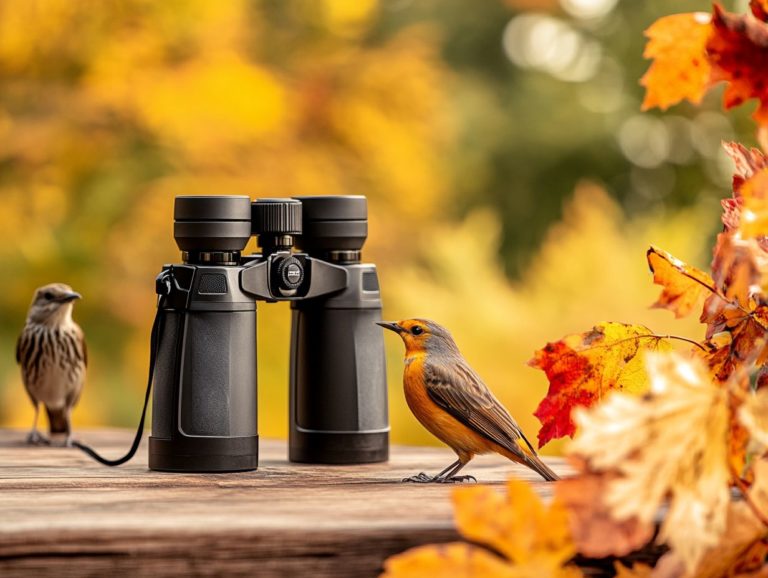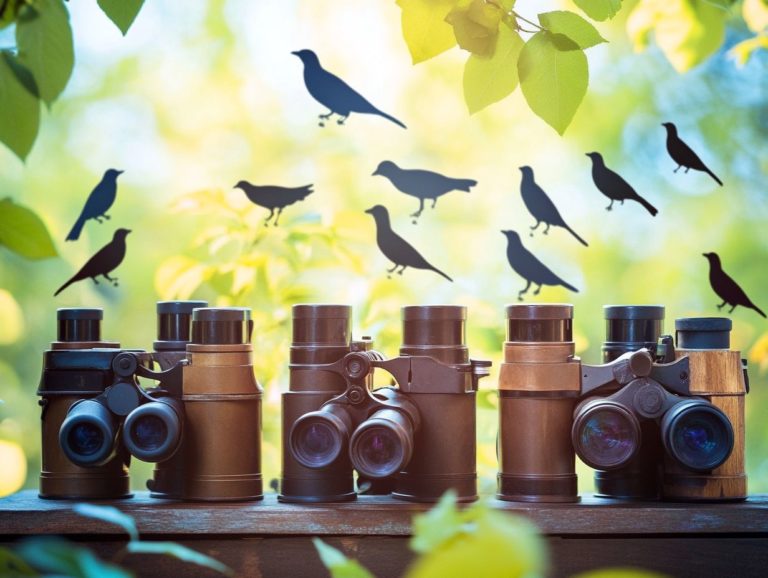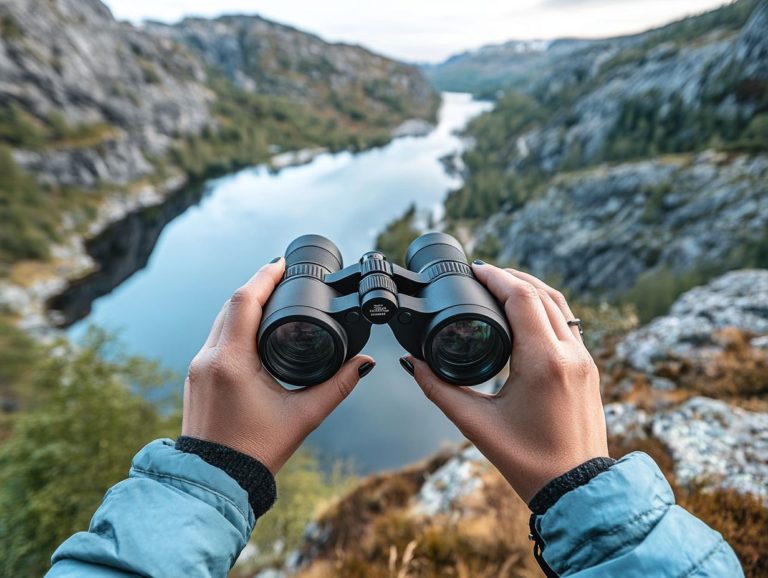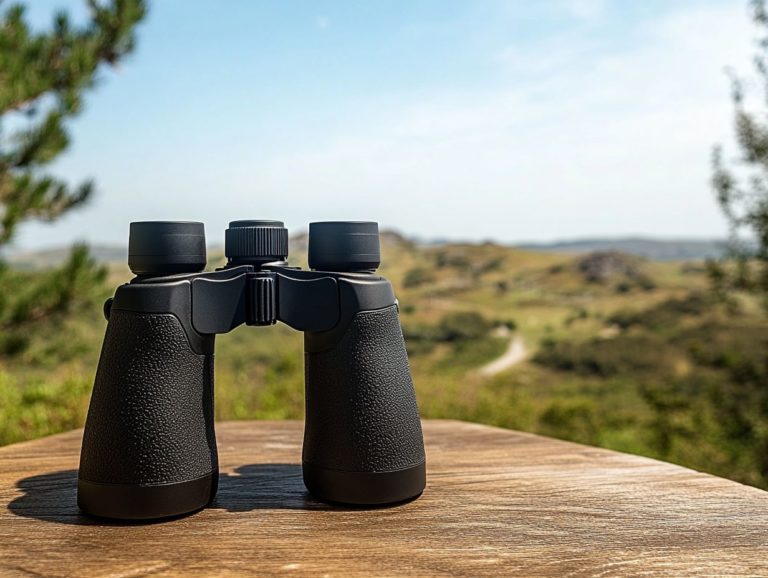Choosing the Right Binoculars for Bird Watching
Bird watching offers a wonderful opportunity to connect with nature, and the right pair of binoculars can truly elevate your experience.
With a multitude of options on the market, it s crucial to understand what makes binoculars ideal for spotting elusive birds. This guide will help you understand the key features to consider, ranging from magnification to durability, helping you identify the perfect type tailored to your needs.
You’ll also discover valuable tips on maintenance and techniques designed to enhance your bird-watching adventures. Prepare to take your explorations in the wild to new heights!
Contents
- Key Takeaways:
- Understanding Binoculars for Bird Watching
- Key Features to Look for in Binoculars
- Types of Binoculars for Bird Watching
- Choosing the Best Binoculars for Your Needs
- Tips for Maintaining and Using Binoculars
- Proper Care and Storage
- Techniques for Better Bird Watching with Binoculars
- Frequently Asked Questions
- What factors should I consider when choosing binoculars for bird watching?
- What is the recommended magnification power for bird watching binoculars?
- Why is lens diameter important in bird watching binoculars?
- Should I go for lightweight binoculars for bird watching?
- What is the ideal field of view for bird watching binoculars?
- Do I need to spend a lot of money on binoculars for bird watching?
Key Takeaways:

- Choose binoculars with appropriate magnification and lens size for bird watching, typically 8x to 10x magnification and 42mm to 50mm lens size.
- Consider the weight and durability of the binoculars along with the prism type and coatings, which can affect image quality and clarity.
- Determine your budget and personal preferences. Test and compare different binocular models before making a decision. Proper care and storage, along with using the right techniques, can enhance your bird watching experience.
Understanding Binoculars for Bird Watching
Grasping the intricacies of binoculars for bird watching is crucial for any serious birder eager to elevate their experience and seize every opportunity for bird identification, particularly in varied outdoor conditions you’ll encounter at events like the Audubon Convention in Milwaukee. Being well-versed in specifications and testing can make a significant difference.
Binoculars are more than just tools; they serve as your gateway to a richer understanding of wildlife. With the right pair, you ll be able to observe birds with remarkable clarity, brightness, and color rendition elements that are vital for distinguishing between various species.
What Makes Binoculars Ideal for Bird Watching?
Binoculars designed for bird watching should deliver exceptional optical quality, enhancing clarity, brightness, and color rendition. For tips on evaluating binoculars for bird watching, this allows you to identify species with precision, even under varying lighting conditions.
For an optimal experience, consider specific features such as magnification power. Options like the 8×42 or 10×42 models provide an excellent balance between detail and stability. The objective lenses are crucial as well; larger lenses tend to gather more light, significantly improving visibility in dim environments. A wider field of view is also beneficial for tracking fast-moving birds, with models like the Swarovski EL 10×42 excelling in this area.
Close focusing capabilities allow you to spot near-flying species, making brands like Nikon a go-to for their versatility in different birding situations. Ultimately, choosing binoculars with these key features will enhance your birdwatching experience, making it enjoyable and effective.
Key Features to Look for in Binoculars
When selecting binoculars for bird watching, focus on several key features that can truly elevate your experience. Magnification is crucial, as it determines how close you’ll get to those feathered friends, and the focusing mechanism you choose can affect ease of use. For detailed guidance, check out how to choose binoculars for long-distance birding.
The size of the objective lenses significantly impacts light transmission and clarity. Additionally, the type of prisms used can affect overall optical performance.
Each of these elements contributes to how well you can immerse yourself in the beauty of nature.
Magnification and Lens Size
Magnification and lens size are essential specifications in binoculars that significantly influence your birdwatching experience. Popular configurations like 8×42 and 10×50 strike a remarkable balance between magnification and field of view, adapting seamlessly to various viewing distances.
For instance, with 8x magnification, you’ll enjoy a broader field of view, making it easier to track fast-moving birds. On the other hand, 10x models deliver greater detail for distant subjects, albeit with a narrower viewing angle.
Lens size also plays a crucial role in light transmission. A larger objective lens, such as the 50mm found in a 10×50 set, enhances brightness in low-light conditions, ideal for those breathtaking dawn and dusk adventures! Just keep in mind that this increased size often means added weight, which could become cumbersome during extended use.
Take the Nikon Monarch 5 10×42, for example it offers exceptional clarity while remaining lightweight. In contrast, the Vortex Viper HD 10×50, although heavier, shines in low-light performance.
Each model has its unique advantages and drawbacks, so it’s essential to carefully consider your specific birdwatching needs before making a choice.
Prism Type and Coatings

The type of prism you choose for your binoculars, whether it’s a roof prism, shaped like a roof for compactness, or a porro prism, offers enhanced depth perception due to its wider stance, plays a pivotal role in shaping how well you can see and the image quality you ll experience as a birdwatcher.
Roof prisms are known for their compact and streamlined design, making them a fantastic option for those who prefer portability while out in the field. On the other hand, porro prisms enrich your experience when observing distant birds.
High-quality lens coatings boost light transmission. This detail enhances clarity and reveals vibrant colors, allowing you to appreciate the subtle hues of feathers and the intricate details of avian life.
Ultimately, choosing the right prism type and lens treatment is essential for anyone serious about their birdwatching adventures.
Weight and Durability
When choosing binoculars for birdwatching, prioritize weight and durability. How to pick binoculars for birding tours emphasizes that lightweight materials enhance comfort, allowing for longer viewing sessions without fatigue.
This consideration becomes even more crucial when you re on the hunt for elusive species in remote locations, where convenience is key. Choosing binoculars that are both waterproof and weatherproof ensures they can endure unexpected elements, from sudden rain showers to high humidity.
Reliable performance in varied environments will significantly elevate your birdwatching experience, giving you the confidence to rely on your gear, come what may. To keep your binoculars performing at their best, make sure to clean them regularly and store them properly. This simple maintenance routine prevents dust and moisture buildup, prolonging the life of these essential tools.
Types of Binoculars for Bird Watching
In the world of birdwatching, you’ll discover a wide range of binocular types, including compact, mid-size, and full-size models, each designed to cater to your specific usage scenarios and preferences.
This variety enhances your experience, allowing you to connect more deeply with the avian world.
Compact, Mid-size, and Full-size Binoculars
Compact binoculars are designed for portability, allowing you to enjoy essential optical features without the bulk. Mid-size and full-size options cater to a broader range of experiences and budgets, offering a larger field of view and enhanced brightness.
When considering compact binoculars, you’ll likely appreciate their lightweight design, making them convenient for hiking or travel photography. However, the trade-off often lies in the ability to see clearly; smaller lenses typically struggle to gather sufficient light, which can limit clarity in low-light situations.
Mid-size binoculars provide a harmonious balance between portability and performance, delivering improved optical quality and a wider field of view especially useful for tracking moving subjects. Brands like Nikon and Vortex thrive in this space, with models such as the Nikon Monarch 5 standing out for their exceptional brightness and clarity.
If you explore full-size binoculars, you ll discover that larger objective lenses can truly transform your viewing experience! These binoculars provide unparalleled optical performance, although they come with a bit of heft. The Swarovski EL series is celebrated for its stunning sharpness and color fidelity, making it a prime choice for enthusiasts eager to invest in a premium experience.
Each category has its unique strengths, so evaluate your specific needs before making a decision.
Choosing the Best Binoculars for Your Needs
Selecting the ideal binoculars tailored to your unique needs as a birder requires thoughtful consideration. You must factor in your budget, personal preferences, and the specific scenarios in which you’ll use them. For guidance, check out how to select binoculars for bird watching tours.
Engaging in thorough testing and comparing different brands and models will elevate your decision-making process. This way, you can choose the perfect pair for your birdwatching adventures.
Budget and Personal Preferences

Establishing a suitable budget and aligning it with your personal preferences is crucial when selecting binoculars. Prices can vary significantly across different models and specifications designed for the birdwatching community. Be sure to check out tips on choosing binoculars for kids’ bird watching that can help you make a more informed choice.
As you consider your spending, reflect on factors like size, weight, optical quality, and specific features that could enhance your viewing experience. If you’re exploring the entry-level range, typically priced between $50 and $150, you can expect basic models with decent optics suitable for casual use.
Mid-range options, costing between $150 and $500, often offer superior image clarity, lightweight designs, and added functionalities like waterproofing. They are perfect for those who take their birdwatching seriously.
On the higher end, exceeding $500, anticipate exceptional optical performance, advanced coatings for low-light conditions, and ergonomic designs that cater to prolonged use ensuring you enjoy an optimal viewing experience.
Testing and Comparing Different Models
Testing and comparing various binocular models is essential for you as a birder. This ensures you select the right pair that perfectly aligns with your unique optical characteristics and usage needs.
In the field, focus on aspects like clarity, brightness, and ease of focus. Observe how well each model performs in varying light conditions to unveil significant differences in brightness levels and resolution. The clarity of the image, especially when capturing fine details like plumage patterns, is crucial.
Evaluating how easily you can adjust focus on fast-moving subjects will help determine whether a particular model suits your birdwatching style. By comparing multiple models side by side, you can better identify your preferences and ensure you make an informed decision that enhances your birding experience.
Tips for Maintaining and Using Binoculars
By implementing proper care and maintenance techniques for your binoculars, you can significantly extend their lifespan and ensure they perform at their best.
Thoughtful storage and mindful usage frequency are essential in preserving their optical quality. This allows you to enjoy clear and vibrant views for years to come.
Proper Care and Storage
Your binoculars are your window to the wild! Proper care and storage are essential to maintaining their optical integrity. Effective cleaning techniques that protect the lenses from dust and moisture are vital for their longevity.
To ensure optimal performance, consider various cleaning methods. Use soft lens cloths or specialized lens cleaning solutions to prevent scratches and smudges. Using lens caps when your binoculars are not in use can significantly minimize exposure to harmful particles.
Storing your binoculars in a protective case is equally important. It shields them from environmental damage and accidental drops. Incorporating accessories like rain guards and eyepiece covers not only protects against the elements but also enhances your overall maintenance routine, ensuring that these valuable tools remain in peak condition for years to come.
Techniques for Better Bird Watching with Binoculars
Employing specific techniques for bird watching can significantly elevate your experience. This allows you to enjoy visual comfort while achieving optimal image quality in your observations.
First, ensuring the correct eye relief is essential, particularly if you wear glasses. Eye relief is the distance from your eyes to the eyepiece, which guarantees a full field of view without any hindrance. Properly adjusting the eyecups can make a notable difference; twisting them up or down helps you find that sweet spot.
When focusing on a distant bird through foliage, try a two-step approach: start by broadly adjusting for distance, then refine your focus for sharper images. In varying light conditions, check your diopter settings to compensate for any differences in vision between your eyes, ensuring every detail from intricate plumage patterns to subtle movements remains crisp and clear.
Frequently Asked Questions

What factors should I consider when choosing binoculars for bird watching?
When choosing binoculars for bird watching, consider the magnification power, lens diameter, weight, and field of view. For more detailed guidance, check out our article on how to choose binoculars for bird watching. These factors determine the clarity, brightness, and ease of use of the binoculars.
What is the recommended magnification power for bird watching binoculars?
The recommended magnification power for bird watching binoculars is 8x or 10x. These powers provide a good balance between magnification and stability, allowing for clear and steady views of birds.
Why is lens diameter important in bird watching binoculars?
The lens diameter determines the amount of light that can enter the binoculars, affecting the brightness and clarity of the image. A larger lens diameter results in a brighter image, making it easier to spot birds in low light conditions.
Should I go for lightweight binoculars for bird watching?
Yes, it is recommended to choose lightweight binoculars for bird watching, as you will likely carry them for extended periods. Heavy binoculars can strain your neck and arms, making it difficult to enjoy your bird watching experience.
What is the ideal field of view for bird watching binoculars?
The ideal field of view for bird watching binoculars is at least 350 feet at 1000 yards. This allows you to scan a larger area and track birds in flight, making it easier to spot and observe them.
Do I need to spend a lot of money on binoculars for bird watching?
Not necessarily. While high-end binoculars may offer better quality and features, many affordable options are suitable for bird watching. To help you make an informed choice, consider checking out the best binoculars for backyard bird watching. Do your research and choose a pair that meets your needs and budget.
Ready to spot some birds? Grab your binoculars and start exploring today!






